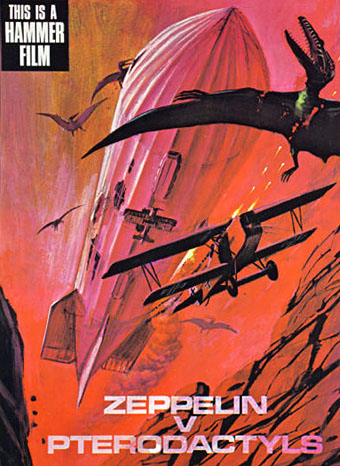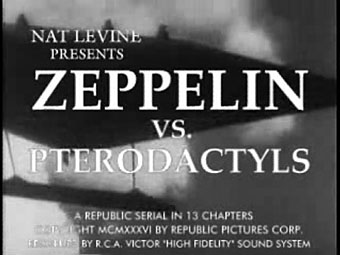
An unmade high-concept from Hammer Films’ early Seventies dalliance with pulp adventure, if you must know. Via Boing Boing via Jess Nevins via Airminded where we learn:
The story was along the lines of THE LAND THAT TIME FORGOT, with a German Zeppelin being blown off-course during a bombing raid on London and winding up at a “lost continent”-type place.
Rather like the Civil War balloon that’s blown off-course in Jules Verne’s Mysterious Island then, which ends up on Captain Nemo’s volcanic island of giant birds and insects. Of course, the mere fact that a film was never made is no obstacle for YouTube’s army of diligent mash-up artists and you can see Zeppelin v. Pterodactyls re-imagined as a 1936 Republic Serial here. (And on a pedantic professional note, an older font should have been used for the titles since Hermann Zapf didn’t design Palatino until the 1940s.)
It was another horror company, Amicus Productions, that produced The Land that Time Forgot (1975) (and its ER Burroughs-derived sequels, At the Earth’s Core [1976] and People that Time Forgot [1977]) so this Hammer concept may have been an attempt to follow Amicus’s lead and exploit the momentary flush of enthusiasm for ERB and co. Or perhaps they thought that Zeppelin movies were the next big thing after Michael York’s First World War adventure, Zeppelin, in 1971. No one in Hollywood these days would dare finance a film with a title like this. The same dumbing-down imperative that gave us Harry Potter and the Sorceror’s Stone (because Americans can’t be trusted to know what the Philosopher’s Stone is) would no doubt want “pterodactyls” replaced by “dinosaurs” or the wording of the whole thing reduced to ZvP.

U-boat vs. dinosaurs! Illustration by Frank R Paul for a 1927 reprint of The Land that Time Forgot.
The Land that Time Forgot was scripted by Michael Moorcock and New Worlds‘ (and Savoy Books) illustrator James Cawthorn. The pair did a decent job with the story although the film as a whole is let-down by silly monster effects, the pterodactyl (or is it a pteranodon?) in this instance being a lifeless thing swinging from a crane. Moorcock and Cawthorn worked together on Tarzan Adventures which Moorcock was editing as a teenager so they appreciated the material at least. This wasn’t the only connection New Worlds had with pulp cinema, more surprisingly JG Ballard had provided a story for Hammer in 1970 with When Dinosaurs Ruled the Earth. Hammer missed an opportunity in not hiring Moorcock for something seeing as he’d just written one of the first retro-dirigible (and pre-Steampunk) novels, The Warlord of the Air, in 1971. UK film producers had some of the best writers in the world under their noses yet could only offer them trash to work on. No wonder the British film industry went down the tubes in the Seventies after the American funding dried up.
My favourite pulp adaptation from Hammer is The Lost Continent based on Uncharted Seas by Dennis Wheatley. A typical Hammer product in the way the story is frequently preposterous yet the whole thing is made with the utmost seriousness. Amazon summarises the plot, such as it is:
This film starts out like The Love Boat on acid, as a cast of unpleasant characters, all with horrible secrets, take a chartered cargo ship to escape their troubles. Unfortunately, the leaky ship is carrying an explosive that can be set off by sea water and it sinks, stranding many characters in a Sargasso Sea populated by man-eating seaweed, giant monster crabs and turtles, and some Spanish conquistadors who think the Inquisition is still on.
Eric Porter is the ship’s captain, a very good actor who was superbly sinister and convincing as Professor Moriarty in Granada TV’s Sherlock Holmes adaptations. The Lost Continent was Wheatley’s shameless plundering of William Hope Hodgson’s Sargasso Sea tales, the book being originally written in 1938 when Hodgson was less well-known than he is today. Until the Pirates of the Caribbean films this was about the closest thing on screen to Hodgson’s world of drifting weed, lost galleons and man-eating monsters, so there you have its cult value. Just be ready with the fast forward button if you try and watch it.
Previously on { feuilleton }
• Moorcock on Ballard
• Coming soon: Sea Monsters and Cannibals!
• Revenant volumes: Bob Haberfield, New Worlds and others
• Druillet meets Hodgson
• Davy Jones
• The Absolute Elsewhere


I would be very tempted by the Zeppelin film, but then, I’d be tempted by anything with an airship in it. I’m also a bit fond of pterodactyls, and I suppose the Nazis in the Zeppelin would make them the obvious heroes….
At least some of Hodgson’s Sargasso Sea stories are very good, but they get a bit tedious if you read too many at once — the Night Shade collections are fantastic. (There are also a lot of other stories in those collections. Carnacki, of course, which was my introduction to Hodgson (“The Whistling Room” in a collection my parents had apparently gotten through a book club), but also a wonderful series of stories about the very clever smuggler Captain Gault, and some really good horror/fantasy (e.g., The House on the Borderlands). Most of the other sea stories are quite good, but you might want to avoid reading too many of those trapped-in-the-Sargasso-Sea, seaweed-and-giant-crabs-and-fiendish-octopi-or-squid stories in a row.)
Also, on the translated Harry Potter note, there are a whole slew of changes made in the U.S. editions; see this website for a list. As an example, in the U.K. editions, there’s a joke about Spellotape. They don’t have cellotape in the States (by that name), so they changed the name, and it no longer reads as a joke. Supposedly the translations got better (i.e., less thorough) with later books.
The forthcoming film of Philip Pullman’s Golden Compass has airships in it, nice elegant ones with brass fittings. I’d agree that a little of those Hodgson stories goes a long way but then many of them were written for magazine publication rather than reading in a collection. And Dennis Wheatley was certainly familiar with them early on, he says as much in introductions to his Library of the Occult series which included The Ghost Pirates and at least one short story.
The challenge of cultural translation should be to try and find a clever equivalent. The Asterix books do this; the original French stories being full of puns which the English translators then find comparable examples of in English. Very clever some of them are, so much so it’s made me wonder sometimes whether the originals worked as well.
Nice summary of this history. What about Calvin & Hobbes’ Tyrannosaurs in F-14s Sunday strip? It does seem to be a rule that the best alternate history novels need zeppelins or other dirigible formats. Wheatley is such an interesting case: so many books published and so completely out of print. All things go in and out of fashion, I suppose.
Heh, I’ve not come across the Calvin & Hobbes one.
Dirigibles seem to survive in fiction out of a feeling that an opportunity was missed. There’s more romance with them (despite the Hindenberg) than there is with planes.
I always regard Wheatley’s example as a caution to authors now who might be hugely popular but whose work is unlikely to last (I’m looking at you, Dan Brown). Wheatley sold millions of books while he was alive but his work now reads like reactionary trash. People who are only writing adventure are easily replaced by newer writers when their work becomes old-fashioned; the ones that last are those that offer some unique vision of their own beyond a thrilling read.
This could only be made better if the Nazis in the zeppelin were air pirates, and the pterodactyls were being ridden by ninjas.
I also loved the whole ‘lost world/ civilization genre.
I think that with the whole CGI effects revolution the genre is set for a revival. i managed to get hold of a copy of THE LOST CONTINENT as a German edition titled BESTIEN LAUERN VIR CARACAS (Destination Caracas- I Think!) it’s totally brilliant and well worth the postage.
If there was to be more lost world movies,decent adaptations of Burroughs Pellucidar series may be a good place to start(there’s even lots of elements of Pirates of the Carribean in a few of the books!), also Lin Cater superb ZANTHODON pastiche series.
Interesting that you made a distinction between the pterodactyl and the pteranodon when describing The Land that Time Forgot. I haven’t seen the film so I don’t know which one was featured, but the two types of pterosaurs are often confused. The beasts featured on the Hammer Films poster at the top of the article are indeed pterodactyls–hats off to the illustrator for knowing the difference.
Pterodactyls have no crests on the backs of their heads, but quite often I have seen crested pteroasaurs labeled “pterodactyls”, maybe because that name is more familiar or it just sounds better. Crested pterosaurs should typically be referred to as “pteranodons”.